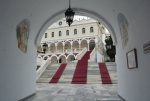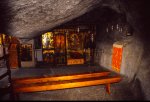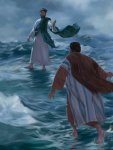Greece.
The island of Tinos.
 Tinos Miraculous Icon
Tinos Miraculous Icon
The Miraculous Icon of Virgin Mary in Tinos: The Church of Virgin Mary (also called Panayia Evangelistria) is probably the most important religious monument in the whole of Greece. It was built in 1823 by the Smyrniot architect Efstratiou to house the miraculous icon of the Holy Virgin. It is an impressive building created using the most expensive marble from Tinos, Paros, and Delos. It is at the end of a broad road which starts from the waterfront and ends up at its lovely pebbled courtyard. It is surrounded by offices, chapels and seven museums. To actually see the icon, you might have to wait in a long queue. The icon is always adorned with jewels that are mostly sent by devout people who have received a miracle.
The discovery of the icon
In June 1822, Pelagia, a nun from the convent of Kechrovounion had visions of the Holy Virgin who told her how much she had suffered after being buried under the ground for many years. The story goes on to say that she was instructed by the Virgin Mary to inform the elders of Tinos Village to begin digging up a piece of land in the field of Ant. Doxaras where they would find a sacred icon. Excavations began and on January 30th, 1823, a worker finally found the icon. These excavations were followed by detailed excavations which have revealed that this was the site of an ancient Byzantine Church and the temple of Dionysos.
The icon called Panagia Evangelistria translating into Our Lady of Good Tidings is a beautiful statue of the Virgin Mary kneeling with her head bent in prayer. Scholars say that the statue is older than the Byzantine Period and was probably the work of the Apostle Saint Luke. It was a sacred icon of the Byzantine church and was either lost or hidden during the Muslim invasions.
Once the icon was discovered, work on the church began. Even before the church was completed, pilgrims from across Greece were pouring in to catch a glimpse of the icon and worship it. There were many reports of miraculous healings that increased the fame of the church. Today it is one of the most venerated and respected icons in the whole of Greece. There are four huge festivals that are celebrated at this shrine, January 30th, the Anniversary of the finding of the icon, March 25th, the Annunciation of the Virgin, July 23rd, The Anniversary of the nun Pelagia and August 15th, the day of the Assumption of Mary.
The miracles
There have been endless recorded miracles that have taken place here. It is therefore hard to estimate the ones that have not been officially recorded. Here are a few of the miracles that have taken place here:
The icon's cover
The first recorded miracle talks of a cover of an unknown material that covered the icon. It was silky and glasslike and looked like it was made of earth and water. It protected the icon acting like a shield through the ages and kept it untouched. The son of G. Peridis was cured of the Plague when he uncovered the icon and took some of the solid matter along with holy water and wiped his son's armpits with it.
The elimination of the Plague
Many people believe that the Plague was eliminated right after the icon was discovered and attribute it to the icon.
One hundred coins
In 1823, the church ran out of money before it was completed. At about the same time, an English ship carrying the vice-consul of England, Eric Flick arrived at the port of Tinos. When the shop anchored, a terrible storm suddenly started and threatened to drown the ship and its people. It is said that the captain of the ship turned his eyes to the half-built church, calling for the Virgin Mary's help and promising to offer a hundred coins. Miraculously, the ship escaped unharmed and the English Captain gave one hundred coins to the Commission of the church to keep his promise.
A child healed
One account says that there was a woman called Mary from Mytilini whose child suffered from a strange and incurable disease. Expensive procedures and immense suffering later, Mary decided to finally ask the Virgin for her help. It is said that the child immediately vomited and out came to an octopus-shaped flesh. After this, the child was healed forever.
The Fishbone
Captain Sclavounos had a fishbone stuck in his throat for two years that just wouldn't come off. With time his throat got infected and he suffered greatly. On hearing about the miraculous icon, he immediately went there praying for relief from his torture when he suddenly had a violent fit of coughing which got the fishbone out.
Crippled healed
Dimitrios Xenos from Moldova was left crippled after he froze one cold night. He was sent to the church of the Virgin Mary where he stayed at the temple of Zoodochos Pigi where he remained as an inmate for four months. On Easter day he heard a voice calling out to him in his sleep asking him to stand up. He not only stood up but also walked much to the surprise of all the people around him.
Faith beyond medicine
Panagiota Nazaou from Falatados had an incurable wound. Her condition worsened so much that the wound developed into gangrene and the doctors were ready to amputate her leg. She turned to the Virgin Mary and was healed. Thereafter she became a nun in the monastery of Kehrovounio.
The fountain of Mustafa Aga
On the way to the church, you can see a marble fountain to the right of the yard. It is the offering of a Turk, Mustafa Aga who was crippled but was cured by the Virgin.
The orange tree
A rich Greek American who was blind asked the Virgin for her healing promising to offer whatever he saw first of his prayers were answered. He did get his sight back and the first thing he saw was an orange tree. He contributed a silver orange tree that you will see over the right candle counter of the church.

2
1
1





